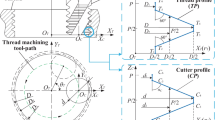Abstract
Thread milling is a method which is increasingly used for machining thread. For this operation, a helical interpolation is required. Furthermore, the thread mill is a tool whose geometry is rather complex. Its envelope profile is linked to the thread profile, and a single tooth of the thread mill is composed of three continuous cutting edges. The present study proposes a geometrical model and an analytical formulation to define the rake face and the cutting edge. Furthermore, the calculations of cutting planes and cutting angles are explained. The analysis shows specific aspects of thread mills, in particular the fact that the flute angle may lead to a negative rake angle. This study is a contribution to cutting geometry aspect and constitutes a step for cutting force model in thread milling.
Similar content being viewed by others
References
Araujo AC, Silveira JL, Jun MBG, Kapoor SG, DeVor R (2006) A model for thread milling cutting forces. Int J Mach Tools Manuf 46:2057–2065
Fromentin G, Poulachon G (2009) Modeling of interferences during thread milling operation. Int J Adv Manuf Technol. doi:10.1007/s00170-009-2372-5
Koelsch JR (2005) Thread milling takes on tapping. Manuf Eng 115:77–83
Halas D (1996) Tapping vs thread milling. Tool Prod 62:99–102
Sheth DS, Malkin S (1990) CAD/CAM for geometry and process analysis of helical groove machining. Ann CIRP Manuf Technol 39(1):29–132
Kang SK, Ehmann KF, Lin C (1996) A CAD approach to helical groove machining. Part 1: mathematical model and model solution. Int J Mach Tools Manuf 36(1):141–153
Hsieh JF (2006) Mathematical model and sensitivity analysis for helical groove machining. Int J Mach Tools Manuf 46(10):1087–1096
Bar G (1990) CAD of worms and their machining tools. Computer Graphics in the German Democratic Republic 14(3–4):405–411
Bar G (1997) Curvatures of enveloped helicoids. Mech Mach Theory 32(1):111–120
Han-Min S (1982) A new method for analysing and calculating angles on cutting tools. Int J Mach Tool Des Res 22(3):177–196
Han-Min S (1986) Graphic determination of geometric angles on metal-cutting tools. Int J Mach Tool Des Res 26(2):99–112
Saglam H, Unsacar F, Yaldiz S (2006) Investigation of the effect of rake angle and approaching angle on main cutting force and tool tip temperature. Int J Mach Tools Manuf 46(2):132–141
Fang N (2005) Tool–chip friction in machining with a large negative rake angle tool. Wear 258(5–6):890–897
Saglam H, Yaldiz S, Unsacar F (2007) The effect of tool geometry and cutting speed on main cutting force and tool tip temperature. Mater Des 28(1):101–111
Kaldor S, Ber A (1990) A criterion to optimize cutting tool geometry. Ann CIRP Manuf Technol 39(1):53–56
ISO 68-1:1998 standard. ISO general purpose screw threads—basic profile—part 1: metric screw threads
ISO 3002-1 Basic quantities in cutting and grinding. Part 1: geometry of the active part of cutting tools—general terms, reference systems, tool and working angles, chip breakers
ISO 3002-2 Basic quantities in cutting and grinding. Part 2: geometry of the active part of the cutting tools. General conversion formulae to relate tool and working angles
Author information
Authors and Affiliations
Corresponding author
Rights and permissions
About this article
Cite this article
Fromentin, G., Poulachon, G. Geometrical analysis of thread milling—part 1: evaluation of tool angles. Int J Adv Manuf Technol 49, 73–80 (2010). https://doi.org/10.1007/s00170-009-2402-3
Received:
Accepted:
Published:
Issue Date:
DOI: https://doi.org/10.1007/s00170-009-2402-3




